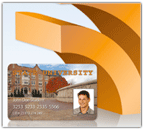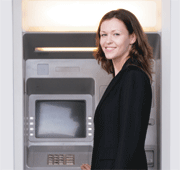Is the future of campus cards contactless?
26 January, 2010
category: Contactless, Corporate, Education, Financial, Library
 New programs are expanding its use beyond access into the full array of campus card functions
New programs are expanding its use beyond access into the full array of campus card functions
By Zack Martin, Editor, Avisian Publications
As campuses switch to contactless smart cards for student IDs and move more applications to the chip are the mag stripes’ days numbered? Greater security, increased convenience and reduced wear and tear on cards and readers are just a few of the reasons leading some campuses to make the switch to contactless technology.
In the next ten years the time will come when there’s no need for a card at all, says Nirmal Palliyaguru, director ACCESS and conferences at Santa Clara University in California. “The next time we re-card there won’t be a card,” he says. “It might be on your cell pone, we’ll have a docking station, and people will upload the card to their cell phone or PDA.”
Santa Clara is deploying Blackboard’s contactless smart card offering for a range of applications on campus. Blackboard partnered with Sony to bring the electronics industry giant’s FeliCa contactless technology to the U.S. market. FeliCa is widely deployed in Japan and other Asian countries with more than 350 million cards and readers used for payment, access and transit solutions, says Jeff Staples, vice president of marketing and business development at Blackboard.
Morehead State University in Kentucky also has fully embraced contactless technology with the help of its campus card vendor, the CBORD Group. Morehead’s new EagleCards include HID Global’s iCLASS contactless technology and enable access, payment and privilege control applications.
According to Mark Doi, director of education market strategies at HID, the drive for increased functionality is encouraging campuses to look at contactless. “We are seeing campuses migrate away from legacy technologies and upgrade their infrastructure over time (with contactless technology), because of the ability to add more applications beyond just opening the door.”
“The education market as a whole has embraced iCLASS as they see the value in comparison to older technologies such as proximity and mag stripe,” adds Doi. In Fall 2008, Doi told CR80News that more than 100 campuses were using or were in the process of migrating to iCLASS.
Clearly contactless has emerged as the premier technology of access control but as Santa Clara and Morehead are proving, it can also benefit other applications as well. Both universities are in the process of implementing the cards not only for physical access but for payments and more.
Time to re-card
It had been ten years since Santa Clara had refreshed its campus card system, Palliyaguru says. The institution was in the process of getting rid of Social Security numbers associated with student IDs and started looking at different technologies that could better protect the information on the card.
In his travels around Southeast Asia, Palliyaguru saw the FeliCa technology in use and he remembered a presentation Blackboard had given on the technology during a NACCU Conference. “This is clearly the next generation and I thought this was the route for us to go,” he says.
Santa Clara is doing a slow rollout of the contactless cards on campus. Incoming freshman and first year law students received the cards first, Palliyaguru says. Anyone needing a replacement card is also receiving one.
Contactless readers from Blackboard are being deployed around campus and will be used at the various points-of sale, as well as vending, laundry and copier locations. The physical access readers are also being converted to accept contactless. The card still has a mag stripe, adds Palliyaguru, so it can be used where the new readers have not yet been deployed.
One of the biggest advantages of contactless on campus is its ability to facilitate transactions, Staples says. “For us the biggest difference is going to be in the high volume, high access areas like dining point-of-sales, door access and other areas,” he says. “We’re able to offer speed, security, and high performance readers that will ultimately impact customer satisfaction. We’re focused on the user experience and want it to be faster.”
It will likely be summer 2010 before the system is completely implemented at Santa Clara, Palliyaguru says. Eventually the campus will issue around 10,000 new cards. Administrators are taking it slow to make sure to troubleshoot any problems as they arise. “The technology hasn’t been used in this field before,” Palliyaguru says. “We don’t know what pitfalls we’ll find.”
While Santa Clara is taking time and care to deploy the new system, Palliyaguru is also focused on the future. He sees a wide range of other applications the card will enable, suggesting that they will “increase the touch points … ticketing, events, fundraising, anything can be done.”
Full deployment at Morehead
Morehead State is moving all of its campus card applications to contactless with the help of system provider CBORD and HID Global’s iCLASS contactless technology. It also has a mag stripe that is used for banking functions and for some of the remaining doors that haven’t switched to contactless, says Doug Snedegar, Morehead’s EagleCard coordinator.
The iCLASS cards are being used with Morehead’s existing Odyssey PCS campus card system from CBORD. To date Morehead has issued 13,500 contactless cards to students and employees, Snedegar says.
The university is no stranger to smart card technology. Since 2001 the Morehead ID has used a contact smart card for beverage, snack, laundry and copiers purchases while the mag stripe was used for physical access.
Payments first
Traditionally when an institution decides to switch to contactless, the first application on the list is physical access. Morehead took a different route rolling out payments first, Snedegar says. The university has 220 contactless readers deployed across campus, but only a handful of these are being used for physical access. The rest are used for dining services, snack/beverage vending, copying and printing and laundry payment.
The contactless readers have proven to be revenue drivers. Vending sales, previously managed with a contact smart chip in the EagleCard, required students to maintain separate accounts for vending purchases. With contactless readers managing purchases across campus, the university now offers students a multi-use account known as BeakerBucks, making it easy to spend and manage EagleCard funds. EagleCard-based vending sales have increased nearly 10% since the change was made, Snedegar says.
Switching to the contactless readers has been a relatively painless process and not too expensive, Snedegar says. The readers deployed at the bookstore, print station and dining services cost less than $250 each.
Deploying contactless at Morehead has given the university unlimited potential for the card, Snedegar says. There are plans underway to extend the contactless infrastructure to Morehead’s regional campuses in Ashland, Prestonburg, West Liberty, Jackson and Mount Sterling. The university is also exploring the use of the card for logical access.
“The sky is the limit,” Snedegar says. “It’s a work in process and our goal is to eventually be contactless everywhere on campus.”
Is this the end of the mag stripe?
At Morehead we discussed whether the stripe would be a thing of the past, Snedegar says. But since the card can be connected to a U.S. Bank account, the mag stripe was necessary for debit purchases and ATM transactions.
Campus card business consultant Bob Huber agrees noting that mag stripes won’t be going away anytime soon. “I think they’ll be around for another 20 years,” he says. “You need to have a mag stripe on the card for merchant acceptance.”
But Huber says contactless on campus may see significant increases in the coming years. Wear and tear on readers and cards is less with contactless than mag stripe and campuses can see a significant cost reduction on that alone, Huber says.
Traditional magnetic stripe readers should have a life of five to eight years, while contactless readers should have an expected life of 15 years or more. Add in the cost of labor for trouble-shooting and service fees for maintenance and repair and contactless provides a total cost of ownership half that of magnetic stripe readers, says Huber.
The reliability of contactless is also on par with mag stripe, suggests Huber adding, “the problem with defective cards is about the same as with mag stripe.”
Read Winkelman, vice president of sales for colleges and universities at CBORD, says interest in contactless on campus is growing. The interest started out of the convenience factor but is growing because of the better security. “As security concerns in general increase, campuses are looking for anything that is more secure, that’s part of what’s driving the interest in contactless,” Winkelman says.




